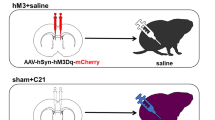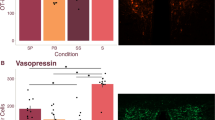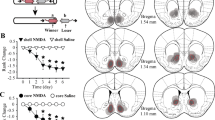Abstract
The involvement of dopamine within the nucleus accumbens in the formation and maintenance of pair bonds was assessed in a series of experiments using the monogamous prairie vole. We show that dopamine transmission that promotes pair bond formation occurs within the rostral shell of the nucleus accumbens, but not in its core or caudal shell. Within this specific brain region, D1- and D2-like receptor activation produced opposite effects: D1-like activation prevented pair bond formation, whereas D2-like activation facilitated it. After extended cohabitation with a female, male voles showed behavior indicative of pair bond maintenance—namely, selective aggression towards unfamiliar females. These voles also showed a significant upregulation in nucleus accumbens D1-like receptors, and blockade of these receptors abolished selective aggression. Thus, neuroplastic reorganization of the nucleus accumbens dopamine system is responsible for the enduring nature of monogamous pair bonding. Finally, we show that this system may also contribute to species-specific social organization.
This is a preview of subscription content, access via your institution
Access options
Subscribe to this journal
Receive 12 print issues and online access
$209.00 per year
only $17.42 per issue
Buy this article
- Purchase on Springer Link
- Instant access to full article PDF
Prices may be subject to local taxes which are calculated during checkout






Similar content being viewed by others
References
Getz, L.L., Carter, C.S. & Gavish, L. The mating system of the prairie vole, Microtus ochrogaster: field and laboratory evidence for pair-bonding. Behav. Ecol. Sociobiol. 8, 189–194 (1981).
Getz, L.L., McGuire, B., Pizzuto, T., Hofmann, J. & Frase, B. Social organization of the prairie vole, Microtus ochrogaster. J. Mammal. 74, 44–58 (1993).
Carter, C.S., DeVries, A.C. & Getz, L.L. Physiological substrates of mammalian monogamy: the prairie vole model. Neurosci. Biobehav. Rev. 19, 303–314 (1995).
Insel, T.R. & Young, L.J. The neurobiology of attachment. Nat. Rev. Neurosci. 2, 129–136 (2001).
Young, L.J. & Wang, Z. The neurobiology of pair bonding. Nat. Neurosci. 7, 1048–1054 (2004).
Winslow, J.T., Hastings, N., Carter, C.S., Harbaugh, C.R. & Insel, T.R. A role for central vasopressin in pair bonding in monogamous prairie voles. Nature 365, 545–548 (1993).
Wang, Z. et al. Dopamine D2 receptor-mediated regulation of partner preferences in female prairie voles (Microtus ochrogaster): a mechanism for pair bonding? Behav. Neurosci. 113, 602–611 (1999).
Gingrich, B., Liu, Y., Cascio, C., Wang, Z. & Insel, T.R. Dopamine D2 receptors in the nucleus accumbens are important for social attachment in female prairie voles (Microtus ochrogaster). Behav. Neurosci. 114, 173–183 (2000).
Aragona, B.J., Liu, Y., Curtis, J.T., Stephan, F.K. & Wang, Z. A critical role for nucleus accumbens dopamine in partner-preference formation in male prairie voles. J. Neurosci. 23, 3483–3490 (2003).
Liu, Y. & Wang, Z.X. Nucleus accumbens oxytocin and dopamine interact to regulate pair bond formation in female prairie voles. Neuroscience 121, 537–544 (2003).
Lim, M.M. & Young, L.J. Vasopressin-dependent neural circuits underlying pair bond formation in the monogamous prairie vole. Neuroscience 125, 35–45 (2004).
Lim, M.M. et al. Enhanced partner preference in a promiscuous species by manipulating the expression of a single gene. Nature 429, 754–757 (2004).
Wang, Z., Hulihan, T.J. & Insel, T.R. Sexual and social experience is associated with different patterns of behavior and neural activation in male prairie voles. Brain Res. 767, 321–332 (1997).
Ikemoto, S. & Panksepp, J. The role of nucleus accumbens dopamine in motivated behavior: a unifying interpretation with special reference to reward-seeking. Brain Res. Brain Res. Rev. 31, 6–41 (1999).
Horvitz, J.C. Mesolimbocortical and nigrostriatal dopamine responses to salient non-reward events. Neuroscience 96, 651–656 (2000).
Salamone, J.D. & Correa, M. Motivational views of reinforcement: implications for understanding the behavioral functions of nucleus accumbens dopamine. Behav. Brain Res. 137, 3–25 (2002).
Di Chiara, G. Nucleus accumbens shell and core dopamine: differential role in behavior and addiction. Behav. Brain Res. 137, 75–114 (2002).
Berridge, K.C. & Robinson, T.E. Parsing reward. Trends Neurosci. 26, 507–513 (2003).
Nestler, E.J. Historical review: molecular and cellular mechanisms of opiate and cocaine addiction. Trends Pharmacol. Sci. 25, 210–218 (2004).
Kelley, A.E. Memory and addiction: shared neural circuitry and molecular mechanisms. Neuron 44, 161–179 (2004).
Wise, R.A. Dopamine, learning and motivation. Nat. Rev. Neurosci. 5, 483–494 (2004).
Carelli, R.M. & Wightman, R.M. Functional microcircuitry in the accumbens underlying drug addiction: insights from real-time signaling during behavior. Curr. Opin. Neurobiol. 14, 763–768 (2004).
Williams, J.R., Catania, K.C. & Carter, C.S. Development of partner preferences in female prairie voles (Microtus ochrogaster): the role of social and sexual experience. Horm. Behav. 26, 339–349 (1992).
Zahm, D.S. An integrative neuroanatomical perspective on some subcortical substrates of adaptive responding with emphasis on the nucleus accumbens. Neurosci. Biobehav. Rev. 24, 85–105 (2000).
Kalivas, P.W. & McFarland, K. Brain circuitry and the reinstatement of cocaine-seeking behavior. Psychopharmacology (Berl.) 168, 44–56 (2003).
Roitman, M.F., Stuber, G.D., Phillips, P.E., Wightman, R.M. & Carelli, R.M. Dopamine operates as a subsecond modulator of food seeking. J. Neurosci. 24, 1265–1271 (2004).
Phillips, P.E., Stuber, G.D., Heien, M.L., Wightman, R.M. & Carelli, R.M. Subsecond dopamine release promotes cocaine seeking. Nature 422, 614–618 (2003).
Cardinal, R.N. & Everitt, B.J. Neural and psychological mechanisms underlying appetitive learning: links to drug addiction. Curr. Opin. Neurobiol. 14, 156–162 (2004).
Reynolds, S.M. & Berridge, K.C. Glutamate motivational ensembles in nucleus accumbens: rostrocaudal shell gradients of fear and feeding. Eur. J. Neurosci. 17, 2187–2200 (2003).
Pizzuto, T. & Getz, L.L. Female prairie voles (Microtus ochrogaster) fail to form a new pair after loss of mate. Behav. Processes 43, 79–86 (1998).
Dewsbury, D.A. The comparative psychology of monogamy. Nebr. Symp. Motiv. 35, 1–50 (1987).
Everitt, B.J. Sexual motivation: a neural and behavioural analysis of the mechanisms underlying appetitive and copulatory responses of male rats. Neurosci. Biobehav. Rev. 14, 217–232 (1990).
Schultz, W. Multiple reward signals in the brain. Nat. Rev. Neurosci. 1, 199–207 (2000).
Panksepp, J., Knutson, B. & Burgdorf, J. The role of brain emotional systems in addictions: a neuro-evolutionary perspective and new 'self-report' animal model. Addiction 97, 459–469 (2002).
Self, D.W., Barnhart, W.J., Lehman, D.A. & Nestler, E.J. Opposite modulation of cocaine-seeking behavior by D1- and D2-like dopamine receptor agonists. Science 271, 1586–1589 (1996).
Ikemoto, S., Glazier, B.S., Murphy, J.M. & McBride, W.J. Role of dopamine D1 and D2 receptors in the nucleus accumbens in mediating reward. J. Neurosci. 17, 8580–8587 (1997).
Missale, C., Nash, S.R., Robinson, S.W., Jaber, M. & Caron, M.G. Dopamine receptors: from structure to function. Physiol. Rev. 78, 189–225 (1998).
Eyny, Y.S. & Horvitz, J.C. Opposing roles of D1 and D2 receptors in appetitive conditioning. J. Neurosci. 23, 1584–1587 (2003).
Kebabian, J.W. & Calne, D.B. Multiple receptors for dopamine. Nature 277, 93–96 (1979).
Kelley, A.E. & Berridge, K.C. The neuroscience of natural rewards: relevance to addictive drugs. J. Neurosci. 22, 3306–3311 (2002).
Ungless, M.A. Dopamine: the salient issue. Trends Neurosci. 27, 702–706 (2004).
Insel, T.R. Is social attachment an addictive disorder? Physiol. Behav. 79, 351–357 (2003).
Champagne, F.A. et al. Variations in nucleus accumbens dopamine associated with individual differences in maternal behavior in the rat. J. Neurosci. 24, 4113–4123 (2004).
Robinson, D.L., Heien, M.L. & Wightman, R.M. Frequency of dopamine concentration transients increases in dorsal and ventral striatum of male rats during introduction of conspecifics. J. Neurosci. 22, 10477–10486 (2002).
Berke, J.D. & Hyman, S.E. Addiction, dopamine, and the molecular mechanisms of memory. Neuron 25, 515–532 (2000).
Schuiling, G.A. The benefit and the doubt: why monogamy? J. Psychosom. Obstet. Gynaecol. 24, 55–61 (2003).
Insel, T.R. & Shapiro, L.E. Oxytocin receptor distribution reflects social organization in monogamous and polygamous voles. Proc. Natl. Acad. Sci. USA 89, 5981–5985 (1992).
Insel, T.R., Wang, Z.X. & Ferris, C.F. Patterns of brain vasopressin receptor distribution associated with social organization in microtine rodents. J. Neurosci. 14, 5381–5392 (1994).
Wang, Z., Young, L.J., Liu, Y. & Insel, T.R. Species differences in vasopressin receptor binding are evident early in development: comparative anatomic studies in prairie and montane voles. J. Comp. Neurol. 378, 535–546 (1997).
Cho, M.M., DeVries, A.C., Williams, J.R. & Carter, C.S. The effects of oxytocin and vasopressin on partner preferences in male and female prairie voles (Microtus ochrogaster). Behav. Neurosci. 113, 1071–1079 (1999).
Acknowledgements
The authors would like to thank F.K. Stephan, M.E. Freeman, K.J. Berkley, R.J. Contreras, C.D. Fowler and M.D. Smeltzer for critical reading of the manuscript and J. Bredesen for technical assistance. This work was supported by US National Institutes of Health grants MH-67396 to B.J.A, HD-40722 to J.T.C, and MH-58616, MH-66734 and DA-19627 to Z.W.
Author information
Authors and Affiliations
Corresponding author
Ethics declarations
Competing interests
The authors declare no competing financial interests.
Rights and permissions
About this article
Cite this article
Aragona, B., Liu, Y., Yu, Y. et al. Nucleus accumbens dopamine differentially mediates the formation and maintenance of monogamous pair bonds. Nat Neurosci 9, 133–139 (2006). https://doi.org/10.1038/nn1613
Received:
Accepted:
Published:
Issue Date:
DOI: https://doi.org/10.1038/nn1613
This article is cited by
-
Nucleus accumbens dichotomically controls social dominance in male mice
Neuropsychopharmacology (2022)
-
A D2 to D1 shift in dopaminergic inputs to midbrain 5-HT neurons causes anorexia in mice
Nature Neuroscience (2022)
-
The nucleus accumbens and ventral pallidum exhibit greater dopaminergic innervation in humans compared to other primates
Brain Structure and Function (2021)
-
Molecular and neural mechanisms regulating sexual motivation of virgin female Drosophila
Cellular and Molecular Life Sciences (2021)
-
Enhanced D2 Agonism Induces Conditioned Appetitive Sexual Responses Toward Non-reproductive Conspecifics
Archives of Sexual Behavior (2021)



